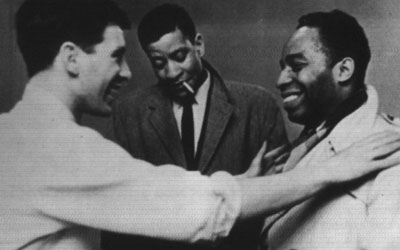SHADOWING SHADOWS
By Jason Guerrasio
 |
| Director John Cassavetes on the set of Shadows, his groundbreaking first feature. |
You could say Ray Carney is a real-life Indiana Jones. A professor of film and American studies at Boston University, he has devoted his spare time to searching for the holy grail — not the one Indiana Jones searched for, but the holy grail of lost films — John Cassavetes’s first version of Shadows.
An authority on Cassavetes’s work, Carney has written five books on the father of American independent filmmaking, and since the late ’80s (around the time of Cassavetes’s death) has been obsessed with finding the alternate versions of his films, most notably Shadows.
When Cassavetes screened Shadows to a select group in the fall of 1958, he was so upset by their response that he reshot most of the movie, creating a second version that upset some who saw both, most notably Village Voice columnist Jonas Mekas. “The second version of Shadows is just another Hollywood film,” Mekas wrote. “The first version is the most frontier-breaking American feature film in at least a decade.”
As years passed, interest in the first version grew, but no one associated with Shadows, including Cassavetes himself, had a clue where it was. After 17 years of searching (and spending between $30,000 and $50,000 of his own money investigating leads), Carney found it last November. Bought by a junk dealer decades ago who thought it was a porno, the 16mm print has been sitting in the attic of one of his children’s houses.
A DigiBeta copy of Carney’s discovery was screened during the opening weekend of this year’s Rotterdam Film Festival — the first time the version has been shown since 1958. “It’s a milestone in American cinema,” says Rotterdam director Simon Field. Critic Stephen Garrett, who saw the film in Rotterdam, says it “doesn’t come off as a rough cut. It’s different, but I think it’s just as strong as the second version. It felt a little more improvised, and you could see the seeds of Husbands in it a lot — the relationships between the men. The first version is more of an ensemble film, and in the second, Lelia’s role is much more central. The whole revelation of her being the sister of a black man, which is set up in the first 15 minutes of the second version, comes halfway through the first. The structure is the same, but [scenes] are changed around — the fight in the alley at the end of the second version happens halfway through the first version. Both versions are accomplished, but after seeing the first you wonder why he wanted to go back. Lelia has a real presence on camera, and perhaps he thought her story is the only one people would care about.”
Shadows v.1 now sits in a temperature/humidity-controlled storage warehouse in Boston while Carney looks for funding to restore it. He’s also working with the Criterion Collection, making a box set of Cassavetes’s work, which will include alternate versions of some of his other films, including Shadows if the restoration is done in time. “In my mind it’s imperative to try to make this available for film scholars, film students and young filmmakers so they can appreciate this method of making film,” says Carney. “It allows us to eavesdrop on Cassavetes’s creative process.”
Now that he’s found the treasure that’s been eluding him for so long, is he finally finished? Not really. “I’m looking for the three-hour version of Husbands,” he says. “It ain’t easy to find.”
Learn more at Carney’s Web site (www.cassavetes.com).
VOD CALENDAR


 See the VOD Calendar →
See the VOD Calendar →


